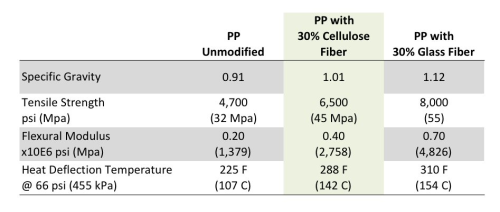
These compounds utilise Weyerhaeuser's THRIVE™ renewable cellulose fibre, which is extracted from trees grown in sustainably managed forests.
| RTP Company's new cellulose fibre reinforced PP compounds overcome many of the obstacles that have hindered the adoption of bio-based resins and natural fibre compounds. They will allow product developers to meet consumer demand for environmentally friendly products that are highly functional yet cost effective. Additionally, they can help processors and OEMs to meet their sustainability objectives by reducing processing costs. |
| Will Taber, Business Manager - Emerging Technologies, RTP Company |
Cellulose fibre reinforced PP compounds have potential uses in a variety of structural injection moulded parts, says RTP, including bezels, bases, brackets, knobs, handles, lids, and housings for the automotive, appliance, furniture, lawn and garden, sporting goods, and toy markets.
The advantages of cellulose fibres
Cellulose fibres can be incorporated into PP to provide increased strength, stiffness and thermal performance (see table).
In comparison to other natural fibres like wood, hemp, and sisal or natural fillers like wood flour and wheat straw, cellulose fibre provides higher strength and stiffness, consistent colour, superior processability, low odour, and a reliable supply, reports RTP.
Advantages of cellulose fibre over glass fibre as reinforcement in PP include:
- renewable content to meet sustainability objectives;
- lower energy consumption during processing;
- specific gravity reductions of 6-9% at like loadings;
- average cycle time reductions up to 30% for medium to thick walled parts; and
- reduced tool wear.
Compared to unreinforced PP, a homopolymer PP with 20% cellulose fibre reinforcement offers a 38% increase in tensile strength, a 75% boost in flexural modulus, and a 60°F rise in heat deflection at 66 psi (16°C at 455 kPa).
RTP also reports that cellulose fibre can be combined with glass fibre or impact modified copolymer for materials that meet requirements of more demanding applications.
These compounds can also incorporate post-consumer recycled PP to maximise their eco-friendly content.





